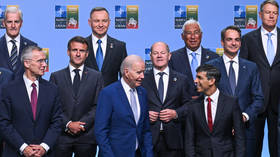Fyodor Lukyanov: NATO looks strong, but the real picture is very different

The North Atlantic Treaty Organization is celebrating its 75th anniversary – the founding documents were signed in Washington this week in 1949. NATO is so firmly embedded in the international landscape that even its decisive transformation at the turn of the 1980s and 1990s did not shake its position.
In theory, the bloc should have been retired, having fulfilled its mission of defending the “free world” against the communist threat. But another logic prevailed: Why abandon an instrument that had worked so well? After all, the main achievement was not even victory in the Cold War itself, which was not in doubt in the West, but the fact that it was achieved without direct military confrontation. It was the result of a policy of prolonged containment and the gradual socio-economic exhaustion of the enemy. In other words, NATO was not a military bloc, but a highly effective political structure that could easily be refocused on other tasks.
The task at hand was a non-trivial one – to become a pillar of the new, Western-centred world order.
Let us leave aside the issue of NATO’s eastward expansion and the development of formerly hostile territories. Much has been said about the role this has played in the rise of European tensions and the emergence of the current politico-military crisis. But something else is even more interesting. The international situation in 2024 shows how the contradictions associated with NATO’s make up, and its unwillingness to change it, are potentially creating increasingly complex problems for the alliance.
The official narrative is that the bloc has never been larger (Sweden has just joined as the 32nd country) or more united. The challenge posed by Russia has, so the story goes, united allies ready to stand together against aggressive imperialist autocrats.
In reality, the mood is complex. The main source of danger is now perceived not to be an adversary (Russia) but rather a leading ally (the United States). The internal political struggle in America – the main casualty of which has so far been military aid to Kiev – and the likelihood of Donald Trump entering the White House are forcing Western European states to consider the unthinkable. Will the United States abandon NATO altogether and shift its priorities? After all, Washington’s declining interest in the Old World is not an anomaly of Trumpism, but a steady trend since the beginning of this century.
The scaremongering about the US leaving NATO under Trump is most likely due to political infighting. Even if the mercurial ex-president wanted to do it, he has no authority to do so. Trump is generally fixated on something else – from his point of view, any grand strategy must bring in money, preferably in the most literal form, as a tariff for services. Hence his calls for NATO and East Asian allies to spend more on their own defense, thereby reducing the burden on the US budget. The more complex argument that control over allies requires investment, but is repaid a hundredfold by the ability to dictate rules, is not remotely interesting to Trump.
But let us reiterate: This is not about him. The Joe Biden administration, which is considered to be “pro-European,” is not averse to transferring a large share of the burden of Ukrainian spending to EU states and even seems to be encouraging them to take the initiative, which was not the case before. The notion of strategic autonomy, hotly debated in previous years, is being reconsidered. Except, now it is no longer just in the form of separate political course.
And here it is worth returning to how NATO was seen in the early 1990s. The contradiction between the Atlantic nature of the alliance and the trans-continental nature of its goals was not resolved at that time. The bloc remained focused on Europe and its environs, and attempts to use it to solve broader global problems did not work very well. Moreover, in the heyday of globalization, it was felt that the most important tools were not military – economic and social means of influence were far more productive.
The changes on the world stage towards militarization and the extreme intensification of major conflicts are forcing a review of capabilities. The US describes the global confrontation as a confrontation between democracies and autocracies, with China as a strategic rival among the latter. This calls for the globalization of NATO and the extension of its practical activities (if not its formal mandate) beyond the Atlantic basin.
Gone is the unified world based on the principles of liberal globalization. In it, the Western alliance could be said to be acting in the interests of security for all. Now NATO, or its incarnations in Asia, cannot claim to perform functions that are needed by everyone. The bloc serves the geopolitical interests of the “collective West.” Accordingly, the problems that NATO enlargement has created in Europe, which have already led to a possible need to fulfil military commitments, are likely to be repeated in Asia. Western Europeans see China as a beneficial partner rather than a threat, but within the framework of a common policy standpoint with the US, their priorities will have to be adjusted.
However, this does not make NATO’s future any more certain.















